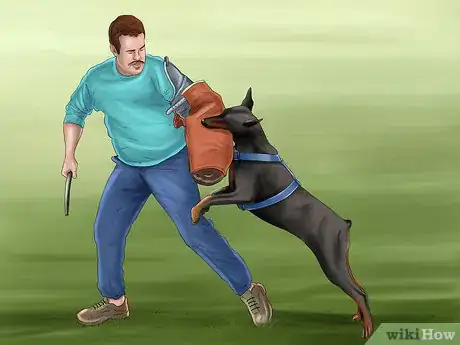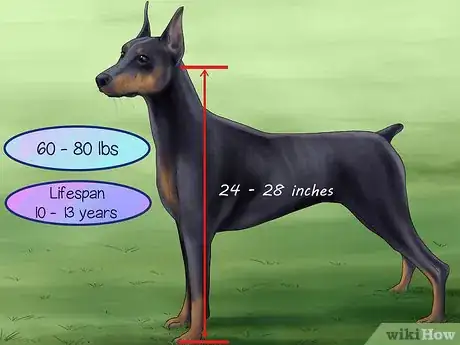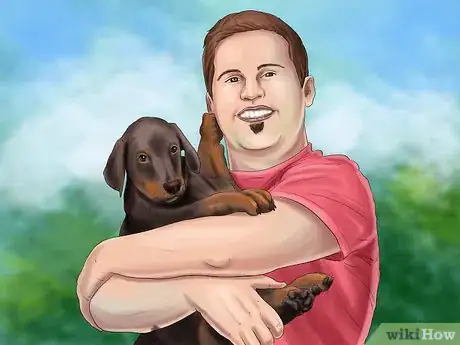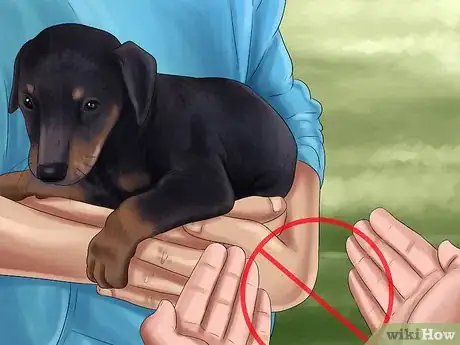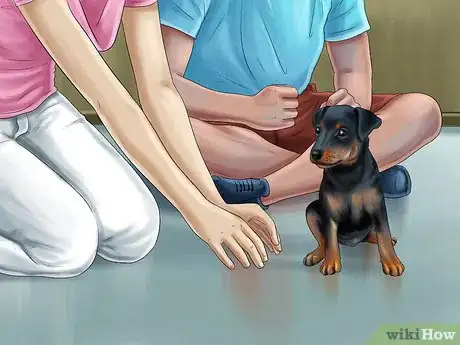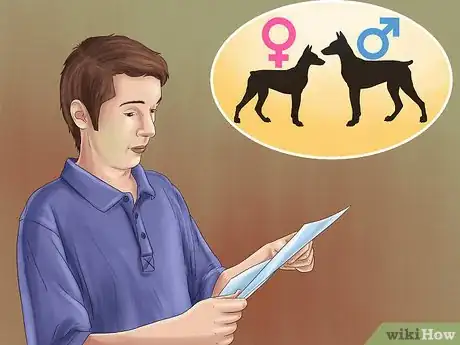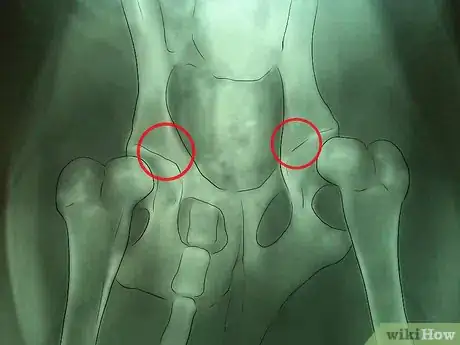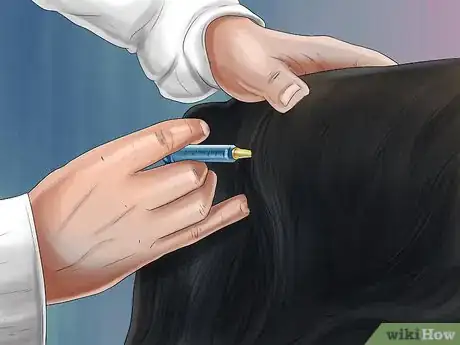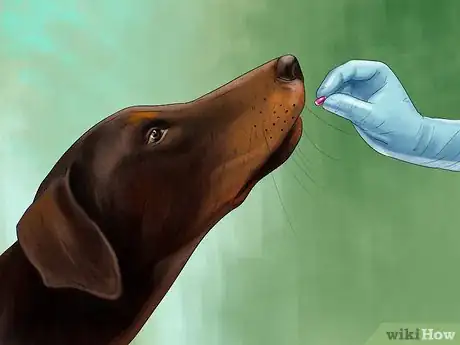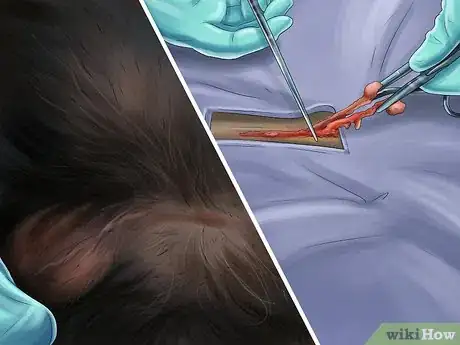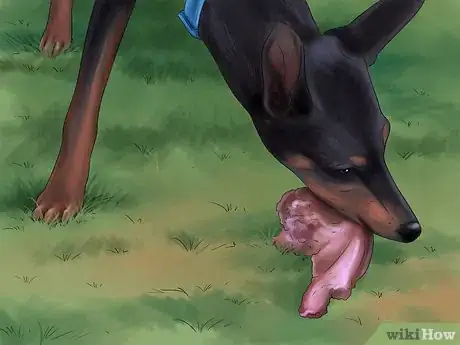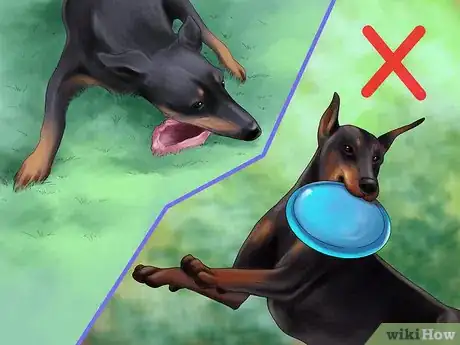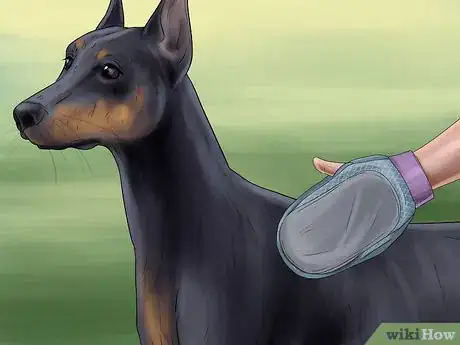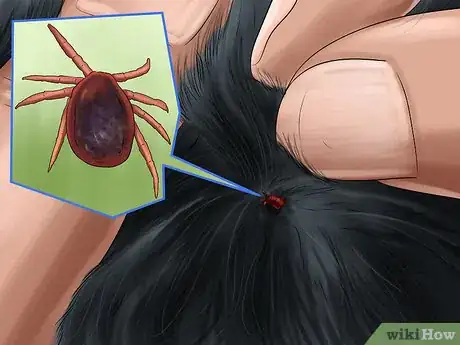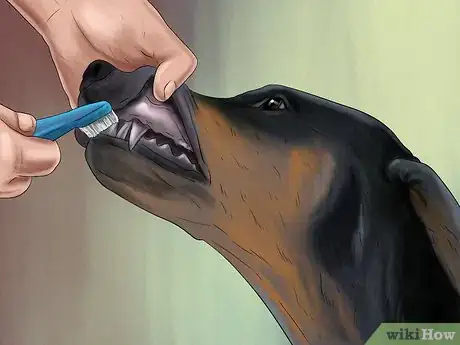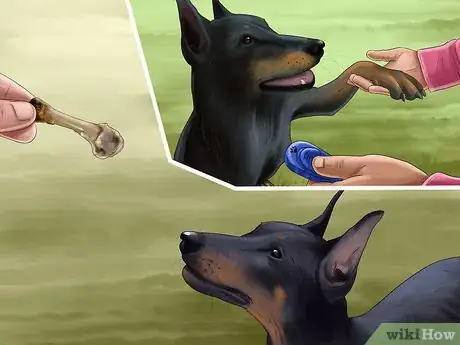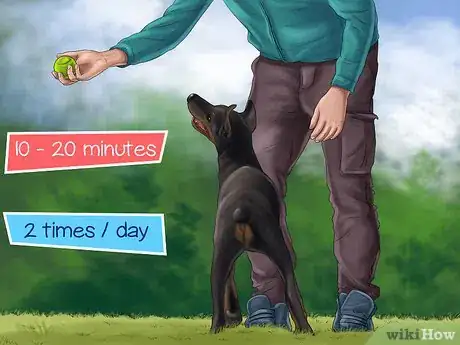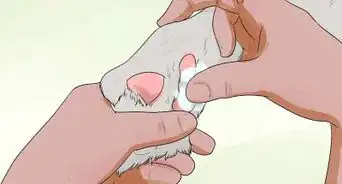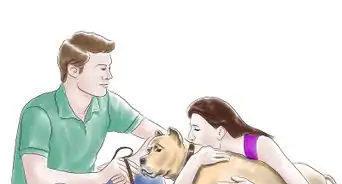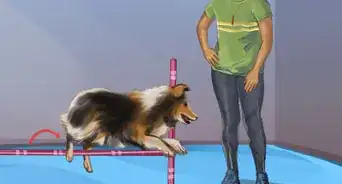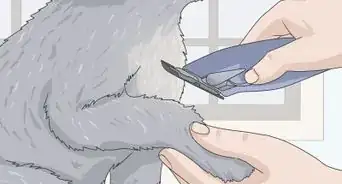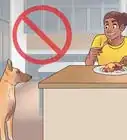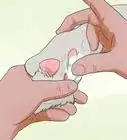This article was co-authored by Pippa Elliott, MRCVS. Dr. Elliott, BVMS, MRCVS is a veterinarian with over 30 years of experience in veterinary surgery and companion animal practice. She graduated from the University of Glasgow in 1987 with a degree in veterinary medicine and surgery. She has worked at the same animal clinic in her hometown for over 20 years.
This article has been viewed 37,224 times.
The Doberman Pinscher is a large, powerfully-built dog breed that originated in 19th century Germany. It seems that the Doberman was developed from breeds such as the Rottweiler, German Pinscher and the Black & Tan terrier to obtain a combination of strength, athleticism and tenacity.The breed was developed as a guard dog and this heritage is still evident today in their strong guarding instinct and territorial behavior. [1]
Steps
Deciding to Get a Doberman
-
1Decide whether you like the temperament of a Doberman. The American Kennel Club (AKC) describes the temperament of the Doberman as energetic, determined, watchful, loyal, and fearless.[2] This goes some way to describe the alert intelligence of the Doberman. When channeled correctly through good training, their energy and willfulness make them a potent working dog and a great pet.
-
2Understand the need for thorough and consistent training with a Doberman. Due to the size and power of the Doberman, if its handler is not knowledgeable and confident, the dog has the potential to become dangerous. The Doberman is not a suitable breed for a first time owner. Indeed, the ideal owner should be an experienced dog owner who is prepared to devote time and attention to the correct training and exercising (both mental and physical) of their dog. If this happens then a Doberman is likely to be a wonderful, attentive, and loyal companion who is devoted to their owner.
- In the wrong hands a Doberman (through no fault of its own) could become either fearful (and therefore aggressive in order to protect himself from perceived threats) or territorially aggressive. Neither is a desirable scenario an out of control doberman is a danger to life and limb.
- A well-trained Doberman can make a great family dog, but supervision is essential around small children as this dog is very energetic and if a small child gets in the way, the dog may push them over.
Advertisement -
3Decide whether your home and yard are big enough for a large dog. Being a large dog, and an athletic one at that, Dobermans need adequate space to move around. Apartment living is not a great option for a dog this active and large unless you will give it enough exercise for your dog to spill out all of its energy. And of course, make sure your land lord allows dog, do not try to hide a dog, ever!
- Indeed, the Doberman also needs access to a decent sized yard, in order to stretch its legs between walks. This yard should also be fenced, as a Doberman may become defensive if a stranger wanders over its territory; keep in mind these dogs were specifically bred to protect.
-
4Make a significant time commitment. You should be prepared to devote at least 2 hours a day to exercising your Doberman, an hour in the morning and again in the evening. Their working origins and athleticism mean they have a high requirement for exercise.
-
5Calculate the cost of owning a Doberman. You should weigh the costs associated with keeping any large dog. You need to provide a good quality food, since cheap foods bulked up with cereal may ferment in the dog's gut and predispose it to bloat. Obviously good quality foods are more expensive than that cheap food, and the cost of feeding the required amount can be considered.
- Also, deworming and anti-parasite treatments are going to cost more than for a small dog.
-
6Understand what a full-grown Doberman will look like. The Doberman should stand around 24 - 28 inches tall at the shoulders, with males being taller than females. The classic color is black with tan markings, but red, blue, and fawn are also permissible by the AKC.[3] The Doberman weighs 60 - 80 lbs and the average lifespan is 10 - 13 years.[4]
- In the US the ears are usually cropped, while in the UK this procedure is considered a cosmetic mutilation and frowned upon.
Choosing a Doberman
-
1Decide between adopting an adult dog from a shelter or buying a puppy from a breeder. There are pros and cons to both. There are lots of dogs in shelters that need homes. These dogs can be great companions but they are less likely to be pure bred dogs.
- One perk of getting a puppy from a breeder is that you get to mold it into a mature adult. If you are committed to thoroughly training a dog, a puppy may be ideal.
-
2Choose your breeder carefully. Never, ever buy a puppy from a puppy mill. A cardinal signs of a puppy mill is the breeder makes an excuse as to why the mother dog is not available to view. This is because in reality the mother dogs is probably hundreds of miles away, waiting to be bred to produce yet more puppies. In the meantime her litter are taken away far too young and transported large distances to places for sale.
- This trade is unethical and immoral, and should not be encouraged by buying these puppies and creating a demand.
-
3Be aware how important socialization is. A good breeder will make sure to socialize his or her dogs in order to guarantee they grow into confident well-adjusted adult dogs. This is especially important for the Doberman, who can be prone to anxiety or territorial behavior. Proper socialization as a puppy helps make the youngster accepting of strangers, rather than suspicious of them. This makes it less anxious and therefore better adjusted to life with people.
- The breeder should make efforts for as many different people as possible to meet the puppies from around 3 - 4 weeks of age, so the young dogs are used to people of different heights, appearances, and tones of voice. The puppies should not be exclusively reared in a kennel as this isolates them from the normal sights, sounds, and activities of a domestic house, and they will find it more difficult to adjust to family life.
-
4Check the family history of a dog you are considering adopting. The Doberman is prone to a number of genetic health problems, some of which the parents can be tested for and some not. For example, Dobermans are prone to hip dysplasia and Von Willebrand's disease.[5] Responsible breeders will screen the parent dogs for hip dysplasia and have certification to show what their score is (the lower the better.)
- A low hip score is no guarantee the puppies won't have poor hip anatomy, but it reduces the risk of this happening.
- There is also a blood test for Von Willebrand's disease, so ideally it would be good to know the parents are negative.
Taking Care of Your Doberman's Health
-
1Be aware of the potential genetic health problems a Doberman may have. The Doberman breed is prone to a number of genetic health problems. These include hip dysplasia, Von Willebrand's disease (a disorder affecting blood clotting), cardiomyopathy, cervical spondylopathy (compression of the spinal cord in the neck area), and bilateral flank alopecia.
- The wise Doberman owner takes out a pet insurance policy in case their dog needs health care. For example, there are some excellent drugs available which can extend the life of a Doberman suffering from cardiomyopathy (disease of the heart muscle) but they are costly, especially given the size of the dog.[6]
-
2Get your dog vaccinated. In terms of routine healthcare, your puppy will need vaccinating against various canine infectious diseases. Exactly which diseases depends on which infections are prevalent in your area. Your veterinarian should advise you about what vaccinations your dog should get.
- Possible vaccinations that your vet may suggest include: distemper, parvovirus, canine adenovirus, leptospirosis, infectious canine hepatitis, parainfluenza virus, and Lyme disease. In addition, a vaccination against rabies is obligatory in many states and you will be breaking the law not to comply.
- Different vaccines are given at different ages. Typically the rabies vaccine is given as a single dose after 12 weeks of age, repeated every 1 to 3 years (depending on the manufacturer) or if given earlier (some brands can be given from 4 weeks of age,) a second dose must be given at or after 12 weeks of age.
- Many other vaccines are given in three doses, 3 - 4 weeks apart, with the final dose always falling around 16 weeks of age.[7] This is so the puppy receives protection from the vaccine at a young age, but not so early that it doesn't benefit from the antibodies provided by its mother.
- Your Doberman should receive yearly booster injections according to the protocol advised by your vet. The vet will select those diseases with are common in the area (core) and those less common (non-core) and discuss which are most appropriate for your dog.
-
3Get your dog dewormed and treated for parasites. Dobermans are likely to spend a lot of time outdoors, so deworming and parasite treatment is essential. Deworming medications come in tablets, oral liquids, oral granules, and spot on treatments. Each product is slightly different, so discuss with your vet which one is best for your pet.
- You should give your dog medication for roundworms (monthly) and a quarterly broad-spectrum dewormer, which stops whipworms and tapeworms.
- Treatment against heartworm is also advisable, either as a six-monthly injection, or a monthly spot-on treatment at home.
- Your dog also should be treated for fleas and ticks. Prevention is better than cure, so this involves using a product effective against fleas and ticks, such as fipronil (Frontline or Effipro) or the Seresto collar. Also, you should check your dog every day for ticks and remove them with a tick hook.
-
4Consider desexing your dog. The obvious advantage of neutering is that it prevents unscheduled breeding. It can also protect the female dog against mammary cancer, if surgery if performed before the bitch's second heat.
- Neutering or spaying should be discussed with your veterinarian. It is usual to operate on females from 4 - 6 months of age, and males around 6 -10 months of age, however, this varies depending on the individual vet clinic.
Feeding Your Doberman
-
1Give your Doberman a good quality food. Look at the label on the bag and make sure a named meat is the first and second ingredient on the bag. Never be tempted to economize by feeding your Doberman on a cheaper food that is bulked up with soy or cereal. These ingredients tend to ferment in the bowel and produce gas.
- Unfortunately, the Doberman is renowned for suffering from a serious condition called bloat, where gas builds up in the stomach which then flips over on itself. This condition can kill the dog. The extra gas generated by a cereal rich diet is something to be avoided.
-
2Never exercise your dog immediately after eating. Wait for at least 90 minutes after feeding your dog before exercising it. Exercising too quickly could cause the dog's stomach to flip over and becoming twisted. This is a life-threatening condition called bloat.[8]
- Signs of bloat include non-productive retching and restlessness or agitation. If your dog is trying to throw up but bringing nothing up, take it to the vet immediately.[9]
- Feeding from an elevated bowl is also said to increase the chances of bloat, so place the dog's food bowls on the floor.
- Eating quickly and gulping down food makes the dog likely to swallow air. If the dog is greedy consider strategies to slow its eating. You can purchase commercial slow-feeders, or consider putting large rocks (be sure they are too big to swallow) in the feeding bowl so the dog has to eat around them, slowing it down.[10]
-
3Feed your dog the right amount of food. Begin by following the portion sizes recommended on the package. However, regularly weigh your Doberman to make sure it is not gaining too much weight.
- Make sure to know what a healthy body shape is for your dog. If you know the ideal, you can judge whether your dog is under, over, or just the right weight.
Grooming Your Doberman
-
1Brush your Doberman once in awhile to bond with it and get it used to your touch. The Doberman is short-haired and its coat actually requires minimal grooming attention. However, burnishing the coat with a rubber mitt helps add gloss and conditions the skin.
-
2Check your Doberman's body on a regular basis. Just be sure to check it over for ticks and awns after each walk. If you find any, remove them.
- Checking your dog's body regularly will help you determine when there is something wrong with it. If you know its shape and function when the dog is healthy, you will be able to identify problems more quickly.
-
3Take care of your dog's teeth. Get in the habit of regular tooth brushing. Use a special dog toothbrush or a finger mitt and dog toothpaste.
- To get your dog used to the process, wet the brush with water and gently rub it on the outer surfaces of the teeth. Once the dog is happy with this, you can introduce a blob of dog toothpaste onto the brush. These pastes are tasty to dogs, don't need rinsing, and are free from substances harmful to dogs if swallowed, such as fluoride.
Training Your Dog
-
1Use a positive-reinforcement training method. Dobermans respond well to clicker training. The idea of this training method is to have the dog associate the click-clack sound of the clicker with a reward. The clicker is used to mark the exact moment the dog shows a desired behavior, so that it understands that is what you want it to do and it will earn a reward for repeating the behavior.
-
2Train your dog to respond to basic commands. Good basic commands to start with are sit, stay, and recall. Once your dog has mastered those, you can build up to more complex obedience training and tricks.[11]
- Given the possessive nature of Dobermans, it is also useful to teach them to fetch, carry, and drop objects. This means the dog learns to relinquish objects to you, and it is also a useful way to occupy the dog's mouth (ie by holding something) if it is in a stressful situation and you are worried about the dog barking or snapping at people.
-
3Train your Doberman on a regular basis. Begin with two 10 - 20 minute sessions per day, depending on the attention span of your dog. If your dog has a lot of energy and has a hard time concentrating, take it for a short walk before a training session. Keep training fun and enjoyable for the dog. If the dog is having a hard time with a command, and you want to end the session, go back to a command they are good at doing before ending the session. This will end things on a positive note and make the dog happier to return to training later.
- Avoid using harsh reprimands or punishments with your Doberman, as this is unnecessary and may drive undesirable behaviors underground.
References
- ↑ http://dogtime.com/dog-breeds/doberman-pinscher
- ↑ http://images.akc.org/pdf/breeds/standards/DobermanPinscher.pdf
- ↑ http://images.akc.org/pdf/breeds/standards/DobermanPinscher.pdf
- ↑ http://dogtime.com/dog-breeds/doberman-pinscher
- ↑ Small animal internal medicine. Nelson & Couto. Publisher: Mosby.
- ↑ Small animal internal medicine. Nelson & Couto. Publisher: Mosby.
- ↑ http://pets.webmd.com/dogs/guide/routine-vaccinations-puppies-dogs?page=2
- ↑ Small animal internal medicine. Nelson & Couto. Publisher: Mosby.
- ↑ Small animal internal medicine. Nelson & Couto. Publisher: Mosby.
- ↑ Small animal internal medicine. Nelson & Couto. Publisher: Mosby.
- ↑ http://www.thedobermannclub.co.uk/
About This Article
To take care of your Doberman Pinscher, feed it with a high quality dog food that has meat as its top 2 ingredients, since a cereal-based diet can cause health problems. You should also exercise your Doberman every day by taking it for 2 15-minute walks. Make sure to wait 90 minutes after your dog has eaten before walking it to avoid causing stomach problems. Additionally, groom your dog every week or two to keep its coat glossy. Along with meeting its basic needs, socialize your dog at a young age, which will help prevent aggression in later life. For tips from our Veterinary co-author on how to train your Doberman, read on!

